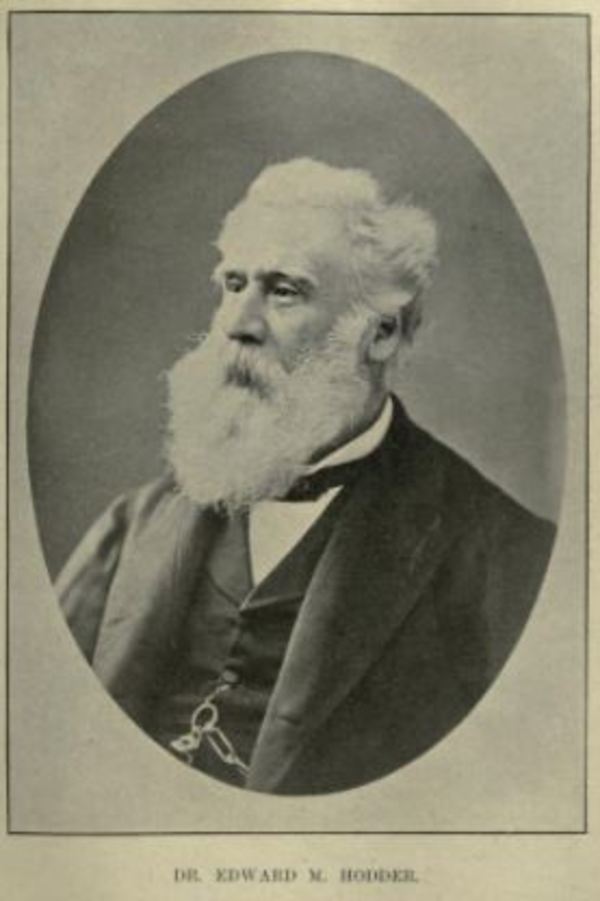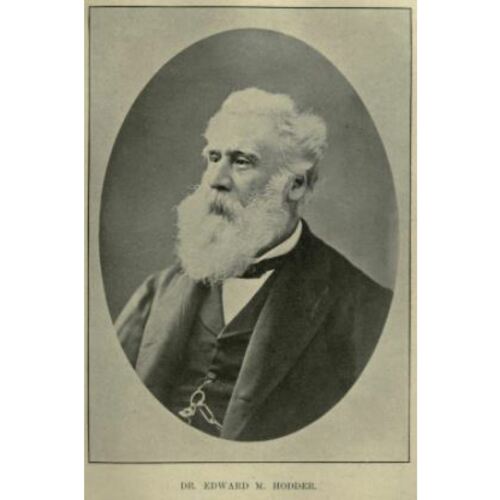
Source: Link
HODDER, EDWARD MULBERRY, physician, surgeon, and educator; b. 30 Dec. 1810, at Sandgate, Kent, Eng., son of Edward and Mary Hodder; d. 20 Dec. 1878, at Toronto, Ont.
Edward Mulberry Hodder was educated on the island of Guernsey and at Saint-Servan, France. At 12 he became midshipman under his father, a captain in the Royal Navy, but he left the service within a year, and went to study medicine in London, under Joseph Amesbury and James Blundell, and in Paris and Edinburgh. He became a member of the Royal College of Surgeons in 1834, and practised at London and later at Saint-Servan. In 1834 he married Frances Tench by whom he had several children.
About 1838 Hodder immigrated to Upper Canada, which he had visited three years before, and settled near Queenston. He moved to Toronto during 1843, and soon established himself as one of its leading medical practitioners. He was granted a cm by King’s College (later the University of Toronto) in 1845. In 1850 he and James Bovell founded the Upper Canada School of Medicine, and after Bishop John Strachan* returned that year from England – he had gone there to obtain support for the establishment of a Church of England university – they offered to have the school constitute the medical faculty of the proposed university. Introductory lectures in the medical faculty of Trinity College were given in November, and Hodder lectured on “Midwifery and Diseases of Women and Children.” In 1851 he established with Bovell the Upper Canada Journal of Medical, Surgical, and Physical Science to which he contributed several articles.
Hodder continued to teach at Trinity College (which granted him an md in 1853) until the closing of the medical faculty in 1856. He then became professor of obstetrics at the Toronto School of Medicine, affiliated since 1854 with Victoria College. When the medical faculty at Trinity College was re-established in 1871, Hodder returned to it. He was unanimously elected its dean, a position he held until his death in 1878.
As perhaps “the acknowledged leader of the profession in Toronto and in the Province of Ontario” Hodder was active in numerous medical institutions and societies. He was appointed the representative of Trinity College on the board of trustees of the Toronto General Hospital in 1853, and was for a long time associated with it as a consulting physician and with the Burnside Lying-in Hospital as the senior physician. He was made an associate member of the Medical Board of Upper Canada in 1853, and in 1858 was appointed its president to succeed Christopher Widmer*. In 1862 he was chosen president of the Toronto Medico-Chirurgical Society and, in 1875, of the Canadian Medical Association at their meeting in Halifax. He was elected a fellow of the Royal College of Surgeons in 1854, and of the Obstetrical Society of London in 1865. At the time of his death he was an honorary local secretary of the latter. He had also served as vice-president of the Canadian Institute in Toronto for 1868–70.
Hodder was an imaginative and respected medical practitioner. During the cholera epidemic of 1854 in Toronto he and Bovell made transfusions of milk into the veins of some patients – with mixed results. Hodder was one of the first to report the use of carbolic acid as an antiseptic in surgery. It was mainly, however, as an obstetrician and gynaecologist that he was prominent, and it was said that “as an ovariotomist he was admittedly the most successful in Canada.” He has been called the “Father” of these two branches of medicine in Ontario.
Hodder retained a love for boating all his life. He was a founder in 1852 of the Toronto Boat Club, which became the Royal Canadian Yacht Club, and participated in many regattas. He published The harbours and ports of Lake Ontario in 1857, a useful compilation for sailors.
E. M. Hodder, The harbours and ports of Lake Ontario, in a series of charts, accompanied by a description of each . . . (Toronto, 1857); “A case of apoplexy, terminating fatally, in which the Caesarean operation was performed with a favourable result to the child,” Upper Canada Journal of Medical, Surgical, and Physical Science (Toronto), I (1851–52), 4–7; “On the poisonous plants which are indigenous to, or which have become naturized in the neighbourhood of Toronto,” Canadian Journal, I (1852–53), 204–7, 218–19; “Transfusion of milk in cholera,” Practitioner (London), X (1873), 14–16.
MTCL, V. M. Roberts papers, memorabilia, 14. Canada Lancet (Toronto), X (1877–78), 215–16. Canada Medical and Surgical J. (Montreal), VI (1878), 428–31. Cyclopædia of Can. biog. (Rose, 1888), 647. Canniff, Medical profession in Upper Canada, 432–34. Middleton, Municipality of Toronto, II, 576, 618–22, 625, 634, 751. W. G. Cosbie, “J. Y. Simpson oration: Simpson and some Toronto contemporaries,” Royal College of Obstetricians and Gynaecologists (London), Report, 1968, 73–80. G. W. Spragge, “The Trinity Medical School,” Ont. Hist., LVIII (1966), 63–98.
Cite This Article
Henri Pilon, “HODDER, EDWARD MULBERRY,” in Dictionary of Canadian Biography, vol. 10, University of Toronto/Université Laval, 2003–, accessed April 28, 2025, https://www.biographi.ca/en/bio/hodder_edward_mulberry_10E.html.
The citation above shows the format for footnotes and endnotes according to the Chicago manual of style (16th edition). Information to be used in other citation formats:
| Permalink: | https://www.biographi.ca/en/bio/hodder_edward_mulberry_10E.html |
| Author of Article: | Henri Pilon |
| Title of Article: | HODDER, EDWARD MULBERRY |
| Publication Name: | Dictionary of Canadian Biography, vol. 10 |
| Publisher: | University of Toronto/Université Laval |
| Year of revision: | 1972 |
| Access Date: | April 28, 2025 |



